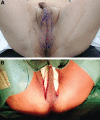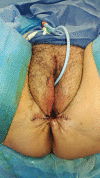Transfeminine Gender Confirmation Surgery with Penile Inversion Vaginoplasty: An Initial Experience
- PMID: 33133914
- PMCID: PMC7572037
- DOI: 10.1097/GOX.0000000000002873
Transfeminine Gender Confirmation Surgery with Penile Inversion Vaginoplasty: An Initial Experience
Abstract
To detail the early experience with and results of a transfeminine (TF) genital reconstruction at an established plastic surgery practice in Western New York.
Methods: Between June 2016 and June 2019, 30 patients underwent penile inversion vaginoplasty for TF gender reassignment. All patients fulfilled World Professional Association for Transgender Health and NY State criteria for reassignment surgery. All surgeries were carried out at a large, government-owned tertiary care center.
Results: There were 30 patients in this retrospective study, with a mean age of 37 years (SD 5.4) and a mean body mass index of 27.3 kg/m2 (SD 3.2 kg/m2). Nineteen patients never smoked, 4 were former smokers, and 7 were current smokers. Primary surgery was an orchiectomy and modified single-stage penile inversion vaginoplasty. Mean operative time was 6.0 hours. Mean initial hospital stay was 8.2 days. Three of the 30 (10%) patients required transfusion. There were 6 (20%) complications. Three complications (10%) required reoperation: 1 patient for wound dehiscence on postoperative day 7, 1 for rectal perforation identified on postoperative day 10, and 1 for urethrovaginal fistula. All complications were addressed without sequalae. Twenty of the 30 (66%) patients have undergone revision surgery. Indications for revision were prolapse correction/deepening, labiaplasty, clitoral hood construction/revision, meatal asymmetry, urinary fistula repair, and posterior vaginal flap revision. Twenty-one of 28 (75%) revisions were outpatient surgeries. There were no complications from these procedures. Overall satisfaction via survey was 92% (24 respondents).
Conclusions: TF gender reassignment is a novel, challenging set of procedures for the specialty of plastic surgery. With appropriate consideration and technique, penile inversion vaginoplasty is a safe, effective means of achieving this goal.
Copyright © 2020 The Authors. Published by Wolters Kluwer Health, Inc. on behalf of The American Society of Plastic Surgeons.
Conflict of interest statement
Disclosure: The authors have no financial interest to declare in relation to the content of this article.
Figures
References
-
- American Psychiatric Association Diagnostic and Statistical Manual of Mental Disorders (DSM-5). 20135th ed Arlington, VA: American Psychiatric Association;
-
- WPATH. World Professional Association for Transgender Health (WPATH) Standards of Care Version 7. https://www.wpath.org/publications/soc. Accessed September 1, 2019.
-
- De Cuypere G, T’Sjoen G, Beerten R, et al. Sexual and physical health after sex reassignment surgery. Arch Sex Behav. 2005;34:679–690. - PubMed
-
- Ainsworth TA, Spiegel JH.Quality of life of individuals with and without facial feminization surgery or gender reassignment surgery. Qual Life Res. 2010;19:1019–1024. - PubMed
-
- Rolle L, Ceruti C, Timpano A, et al. Trombetta C, Liguori G, Bertolotto M.Quality of life after sexual reassignment surgery. In: Management of Gender Dysphoria: A Multidisciplinary Approach. 2015:New York, N.Y.: Springer; 193–199.
LinkOut - more resources
Full Text Sources
Miscellaneous


